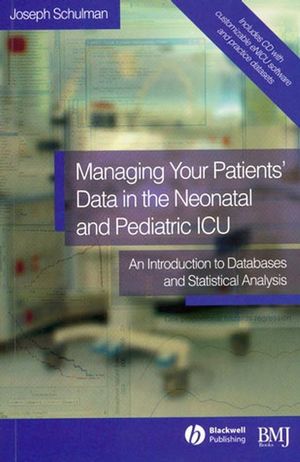Managing your Patients' Data in the Neonatal and Pediatric ICU: An Introduction to Databases and Statistical AnalysisISBN: 978-0-7279-1870-3
Paperback
376 pages
September 2006, BMJ Books
 This is a Print-on-Demand title. It will be printed specifically to fill your order. Please allow an additional 15-20 days delivery time. The book is not returnable.
|
||||||
Part I Managing data and routine reporting.
Section 1 The process of managing clinical data.
2 Paper-based patient records.
3 Computer-based patient records.
4 Aims of a patient data management process.
Section 2 Modeling data: Accurately representing our work and storing the data so we may reliably retrieve them.
5 Data, information, and knowledge.
6 Single tables and their limitations.
7 Multiple tables: where to put the data, relationships among tables, and creating a database.
8 Relational database management systems: normalization (Codd’s rules).
Section 3 Database software.
9 From data model to database software.
10 Integrity: anticipating and preventing data accuracy problems.
11 Queries, forms, and reports.
12 Programming for greater software control.
13 Turning ideas into a useful tool: eNICU, point of care database software for the NICU.
14 Making eNICU serve your own needs.
Section 4 Database administration.
15 Single versus multiple users.
16 Backup and recovery: assuring your data persists.
17 Security: controlling access and protecting patient confidentiality.
Conclusion - Part I: Maintaining focus on a moving target.
Part II Learning from aggregate experience: exploring and analyzing data sets.
Section 5 Interrogating data.
18 Asking questions of a data set: crafting a conceptual framework.
and testable hypothesis.
19 Stata: a software tool to analyze data and produce graphical.
displays.
20 Preparing to analyze data.
Section 6 Analytical concepts and methods.
21 Variable types.
22 Measurement values vary: describing their distribution and summarizing them quantitatively.
23 Data from all versus some: populations and samples.
24 Estimating population parameters: confidence intervals.
25 Comparing two sample means and testing a hypothesis.
26 Type I and type II error in a hypothesis test, power, and sample size.
27 Comparing proportions: introduction to rates and odds.
28 Stratifying the analysis of dichotomous outcomes: confounders and effect modifiers; the Mantel–Haenszel method.
29 Ways to measure and compare the frequency of outcomes, and standardization to compare rates.
30 Comparing the means of more than two samples.
31 Assuming little about the data: nonparametric methods of hypothesis testing.
32 Correlation: measuring the relationship between two continuous variables.
33 Predicting continuous outcomes: univariate and multivariate linear regression.
34 Predicting dichotomous outcomes: logistic regression, and receiver operating characteristic.
35 Predicting outcomes over time: survival analysis.
36 Choosing variables and hypotheses: practical considerations.
Conclusion The challenge of transforming data and information to shared knowledge: tools that make us smart.
References.
Index.
CD ROM: eNICU files; practice data sets back cover.
“Microsoft, Access, SQL Server, andWindows are either registered trademarks or trademarks of Microsoft Corporation in the United States and/or other countries.”



